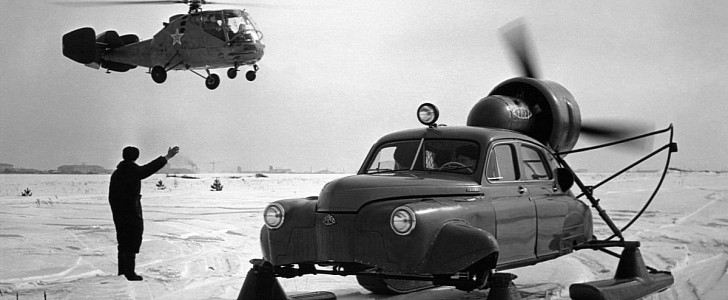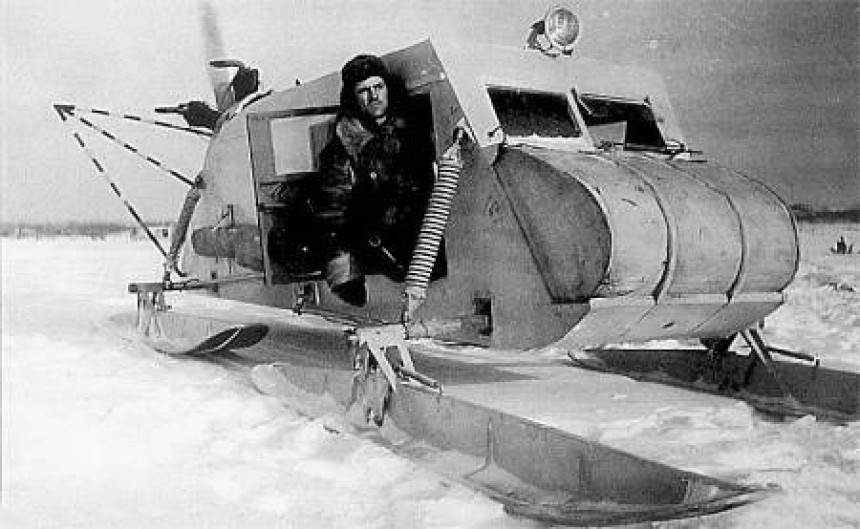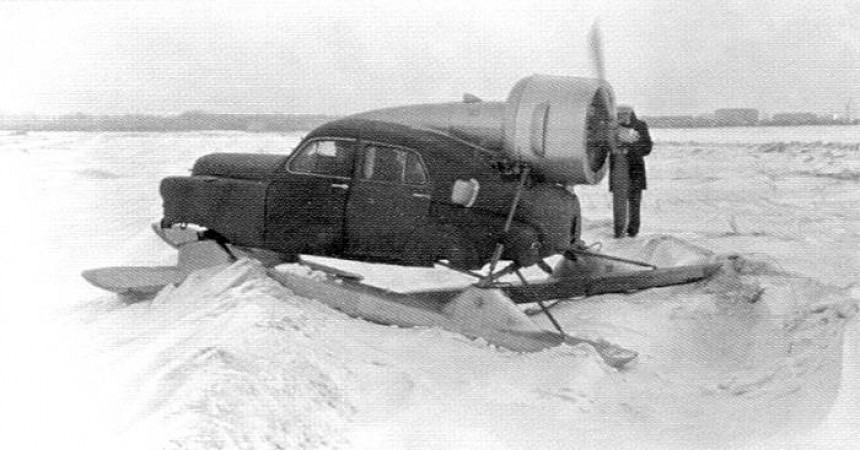Leave It to the Russians to strap a plane engine to a car and some skis just to deliver mail to the good folks in the remote northern regions. The base of the aerosled or aerosleigh was the GAZ-M20 sedan nicknamed “Pobeda” (Victory). Attached to its back was an Ivchenko AI-14 airplane engine producing 260 hp or 194 kW. Also, let’s not forget the Teflon skis it rode or sled on.
A post over on Reddit resurfaced the old 1959 Sever-2 or North-2 (depending on the translation) Aerosled. Now, you might wonder how such a comical yet practical invention came to be. There’s nothing complicated about it. In one way or another, mail has been delivered through aerosleds since the early '40s. After World War II, those early versions were starting to fall apart due to the extreme below-zero temperatures.
These early ones were called NKL-16 and looked more like the back of a New York garbage truck than anything else. That’s not to say the vehicle wasn’t practical. People still got their mail, parcels, and such.
So in the late ‘50s, when an upgrade was called for by the USSR Council of Ministers itself, you can imagine this was no laughing matter. According to sources, even the Ministries of the Aviation Industry and Communications got involved and named the people who would be responsible for the project.
The governmentally approved technical specifications stated that the vehicle would have to be a two-seater. One for the driver and one for the postman, with a large enough space in the back to fit 1,102 lbs. (500kg) worth of items. Also, it should have been able to travel at a speed of 25 mph (50 kph) on snow as deep as approximately 8-12 inches (200-300 mm).
The seaplane float-like-looking skis were made of Teflon material because it had the least friction with the snow out of everything they tried. It even made the sled go faster than the approved speed. Another cool fact about it is that it didn’t have brakes. They had to reverse the engine thrust to "hit the breaks," and that's how they also managed to put it into reverse.
The minds behind the technology chose the Pobeda or Gaz-M20 car model as the body for the sled. It doesn’t really matter what engine the sedan had because they removed it on account of the new “rear-mounted” engine.
The hybrid vehicle started to resemble Frankenstein's monster with all the various vehicle parts that it had retrofitted on it. For example, the front suspension and steering from the Gaz-M20 remained the same, but the suspension of its new "back legs" or skis came from a 1952 Soviet Kamov Ka-15 helicopter.
Mind you, this was no mere chopper. For it was the world's first mass-produced coaxial helicopter, meaning that it had its rotors one above each other. When this is the case, the rotors, while being on the same axis of rotation, they spin in opposite directions.
Too bad the sled didn't need to fly. Otherwise, they would have gotten the entire coaxial system and slapped it on top as well. In fact, maybe that would have been better than the plane engine. Speaking about planes, the Yak-12 airplane provided parts for the engine cooling system.
Except for a few modifications like the new gas tanks under the fenders, or the skis, everything else came from a different type of vehicle. So with a few more “tweaks” here and there, the end result was called the Aerosleigh North-2. A different kind of hybrid vehicle capable of riding in –58F (-50C) temperatures with no issues.
In total, they made 100 of these bad boys between 1960-1961. The North-2 had a good run until 1964, when it was replaced by a wagon body aerosled.
These early ones were called NKL-16 and looked more like the back of a New York garbage truck than anything else. That’s not to say the vehicle wasn’t practical. People still got their mail, parcels, and such.
So in the late ‘50s, when an upgrade was called for by the USSR Council of Ministers itself, you can imagine this was no laughing matter. According to sources, even the Ministries of the Aviation Industry and Communications got involved and named the people who would be responsible for the project.
The governmentally approved technical specifications stated that the vehicle would have to be a two-seater. One for the driver and one for the postman, with a large enough space in the back to fit 1,102 lbs. (500kg) worth of items. Also, it should have been able to travel at a speed of 25 mph (50 kph) on snow as deep as approximately 8-12 inches (200-300 mm).
The minds behind the technology chose the Pobeda or Gaz-M20 car model as the body for the sled. It doesn’t really matter what engine the sedan had because they removed it on account of the new “rear-mounted” engine.
The hybrid vehicle started to resemble Frankenstein's monster with all the various vehicle parts that it had retrofitted on it. For example, the front suspension and steering from the Gaz-M20 remained the same, but the suspension of its new "back legs" or skis came from a 1952 Soviet Kamov Ka-15 helicopter.
Mind you, this was no mere chopper. For it was the world's first mass-produced coaxial helicopter, meaning that it had its rotors one above each other. When this is the case, the rotors, while being on the same axis of rotation, they spin in opposite directions.
Except for a few modifications like the new gas tanks under the fenders, or the skis, everything else came from a different type of vehicle. So with a few more “tweaks” here and there, the end result was called the Aerosleigh North-2. A different kind of hybrid vehicle capable of riding in –58F (-50C) temperatures with no issues.
In total, they made 100 of these bad boys between 1960-1961. The North-2 had a good run until 1964, when it was replaced by a wagon body aerosled.








